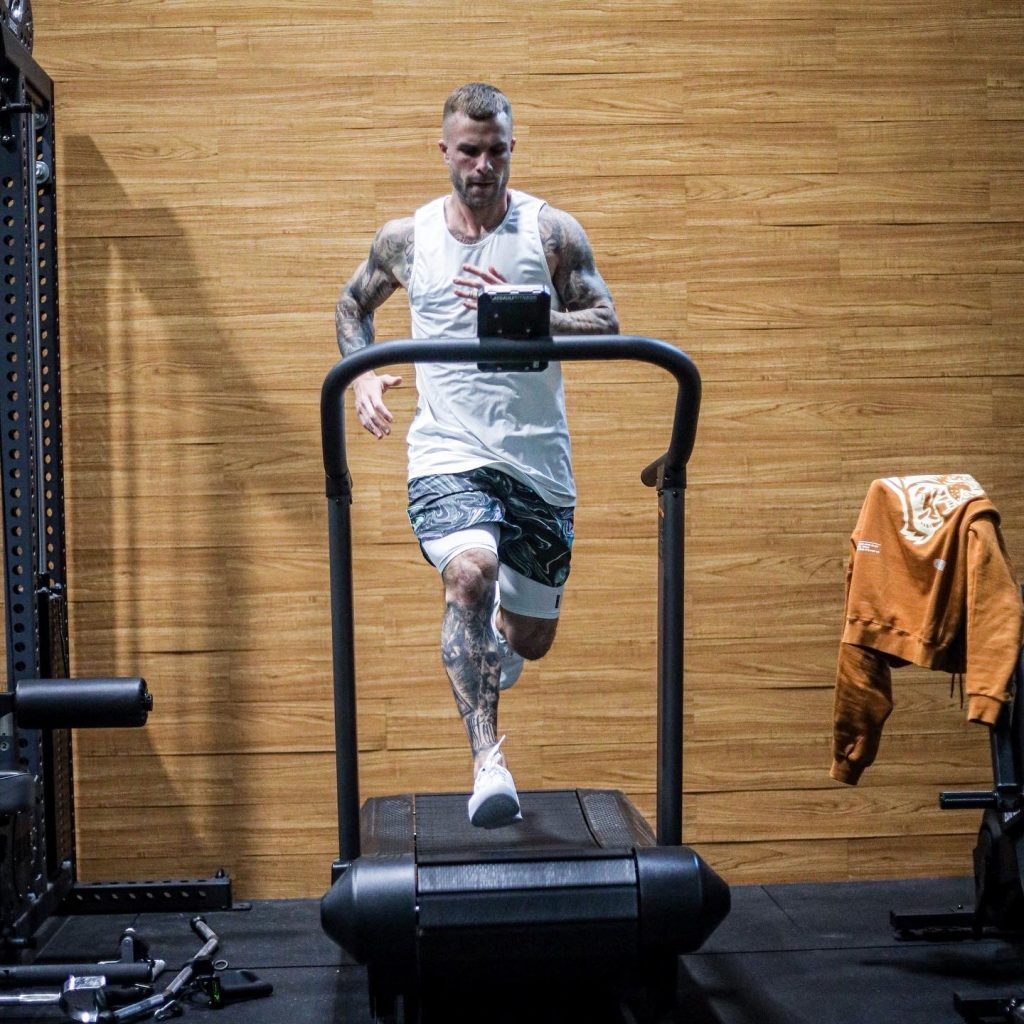Introduction: What is Concurrent Training?
Concurrent training consists of combining aerobic/anaerobic training (e.g., long distance running, HIIT) with resistance training, also known as strength training.
If you look at the American College of Sports Medicine (ACSM) guidelines, they recommend at least 150 minutes of moderate intensity aerobic activity and two or more sessions of resistance training every week. By doing this, you can reap the health benefits of exercise, which include the regulation of blood pressure, management of anxiety and depression and the prevention of weight gain. This means to achieve optimal health, you should be concurrent training.
If you’re reading this guide, you likely exercise much more than the ACSM guidelines. We can help you maximize the effects from both resistance and aerobic training to improve your performance or physique. To determine how to optimize your concurrent training routine for your goals, let’s take a closer look at the history of concurrent training and use cases that have helped us determine how to create a concurrent training plan for different end results.
History of Concurrent Training
Dr. Robert Hickson
The first concurrent training study was completed by Dr. Robert Hickson in 1980. He took an extreme approach by doing a “proof of concept” study.
He compared three groups:
- A strength group that exercised 30-40 minutes per·day, 5 days·week
- An endurance group that exercised 40 minutes per·day, 6 days per·week
- A concurrent group that performed the same daily exercise regimens as both the strength and endurance groups.
After 10 weeks of training, VO2max increased by 20% when measured during treadmill exercise in both endurance, and concurrent groups. No increase in VO2 max was observed in the strength group, which makes sense because they weren’t doing aerobic exercise. There was a consistent increase in leg-strength by the strength group throughout the training, whereas the endurance group did not improve much. The rate of strength improvement by the concurrent training group was similar to the strength group for the first seven weeks of training, but subsequently leveled off and declined during the 9th and 10th weeks of training.
These findings demonstrate that simultaneously training for strength and endurance will result in a reduced capacity to develop strength, but will not affect the magnitude of increase in VO2 max. Ultimately, Dr. Hickson discovered that the strength but not endurance development may be compromised when completing a high frequency of intensive running and strength training sessions for 11 weeks. Hickson also argued that the compromised strength adaptations were not attributed to residual fatigue, despite the high volume of aerobic and strength training but the possible mechanisms behind these findings remained to be elucidated. Ever since this study, this phenomenon is known as the “interference effect.”
Dudley and Djamil
In 1985, Dudley and Djamil tested the initial observations of Dr.Hickson by performing a study with a much lower training frequency over seven weeks. The endurance group completed five bouts of five minute on a cycle ergometer for three days per week at VO2 peak. The strength group completed two 30-second sets of maximal knee extensions three days per week.
The concurrent training group completed alternating days of strength and endurance training. Hopefully, you can see the massive difference in training volume compared to Hickson’s study. The main findings of Dudley & Djamil’s study was that the interference effect was only observed at high but not low velocities when testing power in the knee extension. We’ll see this idea resurface later in the section on meta-analyses.
Craig et al (And Many Others)
Later (1990s) it was hypothesized by many scientists that residual fatigue induced by aerobic exercise may compromise the ability to develop tension during the subsequent strength training, when both exercises are performed in close proximity.
Specifically, aerobic training compromised the total volume of strength training, which may lead to impaired chronic neuromuscular adaptations, as observed in the initial study by Hickson. There was plenty of support for this idea.
For example, in a study by Craig et al., in 1991, lower body strength gains in previously untrained students were minimal when running was consistently performed directly prior to strength training. However, no impairments were found in upper body strength, indicating the interference effect to be a local to the muscle rather than a central nervous system phenomenon indicating that the running was interfering with the muscle strength in the legs. This set the stage for research on exercise order – should we do cardio or strength training first?
A few years later, in 1993, other researchers expanded on the findings of the previous studies by comparing two different exercise orders (aerobic -> strength, or the opposite).
The 7‐week training program consisted of strength training using 10 exercises for two sets of 3–12 repetitions and running for 20–25 min at 60–90% of heart rate reserve (HRR). Maximal oxygen uptake (VO2 max) was measured during a graded treadmill test, and muscular strength was assessed using 1RM tests for the bench press (BP), shoulder press (SP), arm curl (AC) and leg press (LP). The authors found that there were no significant differences between the two experimental groups for the BP, AC, and LP; however, the group that performed endurance training first increased SP strength more than the group that did strength training first. This training protocol offered a lot of flexibility in intensity (e.g., HRR) and rep ranges, plus it was low volume, which is likely why there was no interference-effect.
As we fast-forward a decade, we see a string of studies that add insight to how and when the interference effect occurs. These studies started to dive into the molecular mechanisms behind the hypothesized interference-effect.

Molecular Mechanisms of Concurrent Training
Scientists have tried to use molecular biology to maximize concurrent training. This revolves around a few main signaling factors in skeletal muscle: mTORC1, PGC-1a and AMPK.
After resistance training, there is an increase in the activity of mTORC1 in humans via AKT phosphorylation. This leads to downstream phosphorylation of p70S6K and subsequent activation of muscle protein synthesis. This pathway indicates mTORC plays an important role in muscle hypertrophy.
AMPK is considered the energy sensor of the muscle cell and plays a role in fat oxidation. During endurance training, a series of events activate AMPK, which ultimately leads to PGC-1a upregulation causing mitochondrial biogenesis. Mitochondria (yes, say it with me: the powerhouse of the cell) is one of the most important endurance adaptations. The endurance-induced decrease in glycogen also activates p38 MAPK, which further acts on PGC-1a. Finally, the calcium released during contraction increases CaMK, which also acts on PGC-1a.
Low energy availability and increased energy deficit result in AMPK activation and ultimately causes the inhibition of mTOR signaling. Increases in AMPK activation, during and after a continuous endurance training seems to have a dose–response relationship with the endurance training load/volume and/or intensity, e.g., higher loads, longer durations, and higher intensities resulting in higher activation of AMPK.
To sum it up so far: AMPK signaling selectively mediates aerobic exercise adaptations, mTORC signaling facilitates resistance exercises adaptations, and the interference effect indicates these signals compete with each other.
This was proven true in one study, (Thomson et al., 2008) that used a rodent model to demonstrate that AMPK up-regulation indeed interfered with mTOR signaling. The energetic perturbation caused by aerobic exercise favors mitochondrial adaptation and theoretically overrides growth signaling from resistance exercise. While interesting, several of these studies were performed in rodents, utilized short-term aerobic- and resistance exercise-like stimuli, and did not include a concurrent exercise comparison.
Two studies in humans, by John Hawley, help us better understand when the interference effect might occur. In the first study, they showed that activation of the mTORC1 following eight sets of five repetitions at 80% 1RM was lost if the participants had performed ten 6-second maximal sprint efforts on a bicycle 15 minutes before strength training, and mTOR activity rapidly returned to baseline if the sprint session was performed after strength training.
In the next study they used a moderate intensity bout of cycling, and there was no difference in mTORC1 activity. These findings are consistent with the training data that show that the interference effect is only seen if the subjects train at a high aerobic frequency and intensity.
Residual fatigue was initially theorized (in Hickson’s studies) to provide a possible explanation for the interference effect because of the decline in strength adaptation occurring in the latter stages of the training. This is likely true and the lack of glycogen can hinder the quality of subsequent resistance exercise or the capacity for prior endurance exercise to reduce muscular peak torque via a decline in the neural input to the muscle and peripheral contractile mechanisms. If we look at the studies using glycogen depletion, they agree with the residual fatigue theory because strength and volume declines as you become more fatigued.
Reviews and Meta-analyses on Concurrent Training
The first meta-analysis on concurrent training was conducted in 2012 by Wilson et al., who demonstrated the negative effect of endurance exercise on muscle hypertrophy, strength and power that occurs in a frequency- and duration-dependent manner (Wilson et al. 2012).
The mode of exercise may also have an impact on the magnitude of the interference effect with running, likely to have a greater negative effect on strength development than cycling, possibly due to the eccentric component of running and concomitant muscle damage. Interestingly, the training-induced gains in aerobic capacity were not compromised by concurrent strength and endurance training.
The next stop on the train isn’t a meta-analysis, but instead an opinion article. In 2016, two excellent scientists (Dr. Bagley & Dr. Murach) compared some studies with concurrent training to determine whether they influenced muscle hypertrophy. They found that in human training studies with close-succession concurrent exercise there was no difference in whole muscle hypertrophy compared with resistance exercise alone.
They also noted that from a practical standpoint, strength impairments following an endurance exercise bout (high intensity or submaximal continuous) can last for at least 6 hours. In the studies reviewed, training was vigorous, but overall exercise duration was relatively low, and frequency was not high (<4 days/week). Thus, minimizing the overall volume of exercise throughout the week is an important consideration for maximizing the hypertrophic potential of concurrent training.
In 2018, another meta-analysis was published focused on high-intensity interval training as part of concurrent training. The purpose of the review was to determine if the interference effect is influenced by comparing concurrent HIIT and RT to RT alone on measures of strength and hypertrophy via a systematic review and meta-analysis.
The authors analyzed 13 studies in total. The main finding was that concurrent training with HIIT had no effect on upper body strength and muscular hypertrophy. However, there was a greater increase in lower body strength following RT alone compared to concurrent HIIT + RT.
A sub-analysis revealed that the decrease in lower body strength may occur with cycling but not running. This data means that HIIT can be prescribed alongside RT without negatively impacting changes in lean muscle mass and that any attenuation of lower body muscular strength might be prevented by prescribing running-based HIIT and providing adequate rest between HIIT and RT sessions. It is important to consider that concurrent HIIT + RT as well as RT alone both improved dynamic strength across all studies. Also, because HIIT has been shown to improve VO2max and speed, the slight reduction in lower body strength may be a small price to pay for improvements.
Shortly afterward, another meta-analysis was published to assess whether intra-session concurrent training routines modify strength-based outcomes associated with the interference effect.
The authors found that intra-session exercise sequence during a prolonged (>5 weeks) concurrent training program significantly affected the improvements in lower-body dynamic strength, with a resistance followed by endurance exercise order superior to the alternative sequence. Meanwhile, the training outcomes of lower-body static strength and muscle hypertrophy were not affected by intra-session sequencing of the exercise mode. This review indicates that we should be training for endurance after our resistance training is done.
Finally, the most recent meta-analysis on the topic was published in 2021, which assessed the compatibility of concurrent aerobic and strength training compared with strength training alone, in terms of adaptations in muscle function (maximal and explosive strength) and muscle mass.
The main finding was that concurrent aerobic and strength training did not interfere with the development of maximal strength and muscle hypertrophy compared with strength training alone. Yet, the development of explosive strength was reduced by concurrent training. The subgroup analysis was only significant within the explosive strength measurements, indicating that there was a detrimental effect of doing concurrent training within the same session, but if separated by three hours the effect disappeared. Therefore, if your goal is to increase explosive power, it is best to complete the aerobic portion of your concurrent training at least 3 hours after the strength training portion or on a separate day.

Practical Application
Interested in incorporating a concurrent training routine into your workout schedule? Here are a few examples of practical applications to consider:
Goal: Aerobic Performance
Concurrent training does not negatively affect endurance performance. If your main goal is to run farther or faster, then you should resistance train two to three times per week ideally on non-running days so that you get the most out of both exercise modalities.
Goal: Muscle Hypertrophy
There is very little data suggesting that concurrent training prevents muscle hypertrophy. If your main goal is to increase muscle size, then plan your aerobic exercise so that it does not lower the intensity or volume you are able to do in your resistance training program.
HIIT may be a better option than LISS if it does not increase in fatigue (or nagging injuries) over time. Always do resistance exercise prior to aerobic exercise and separate them by at least 3 hours if completed on the same day.
Goal: Muscle Strength
There is sufficient data that concurrent training will decrease lower body strength if the aerobic portion is completed at a moderate or high volume. Therefore, use aerobic exercise sparingly and try to do low-volume HIIT instead of LISS. If possible, separate exercise modalities and use running-based aerobic exercise instead of cycling.
Goal: Muscle Power
There is strong data to suggest that concurrent training will decrease muscle power. Thus, try to use minimal aerobic exercise and use low-volume, high-intensity movements when necessary. Separate aerobic and resistance training as much as possible, but at least by 3 hours.
Goal: General Health
Concurrent training will not interfere with overall health goals and most exercise guidelines encourage it. Your program should incorporate 2-3 days of resistance training and 2-3 days of aerobic training.
For more information on concurrent training and other methods of exercise, learn about our opportunities for online coaching today.






















































































































































































































































































































































































































































































